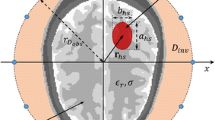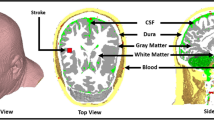Abstract
This paper presents a simulation-based study on detection of stroke/brain hemorrhage even in the white matter using radio channel characteristics analysis. The idea is to utilize the fact that blood has different dielectric properties than brain’s white and grey matters and, thus, additional blood areas inside the brain change radio channel characteristics between the transmitter and receiver antennas located on the opposite sides of the head. The antennas should be strongly directive and designed to work attached to the body surface so that hemorrhages even in the white matter could be detected. The study is conducted using the electromagnetic simulation software CST and two different simulation models: a spherical tissue layer model and an anatomical voxel model. The antennas used in this study are bio-matched mini-horn antennas designed for implant communications at 1–4 GHz frequency range. Different sizes of the blood areas are evaluated. This initial study shows how even small sizes of hemorrhage can change radio channel even as the hemorrhage is located in the middle of the brain, in the white matter. The path loss difference is 0.5–10 dB between the hemorrhage and reference cases depending on the size and location of the hemorrhage. A practical solution of this hemorrhage detection technique could be a portable helmet type of structure having several small sized antennas around the internal part of the helmet. Such a helmet would be easy to use e.g. in ambulance, which would enable early detection of hemorrhage in its early phase and, hence, improve prospects of the cure significantly.
Access this chapter
Tax calculation will be finalised at checkout
Purchases are for personal use only
Similar content being viewed by others
References
Wang, D.-D., Chen, D.-Y., Luan, H.-S., Peng, H.-L.: A new method for transcranial vortex microwave beam imaging. In: 2018 International Conference on Microwave and Millimeter Wave Technology (ICMMT), pp. 1–3 (2018)
Abbosh, A.: Microwave systems for head imaging: challenges and recent developments. In: 2013 IEEE MTT-S International Microwave Workshop Series on RF and Wireless Technologies for Biomedical and Healthcare Applications (IMWS-BIO), Singapore, pp. 1–3 (2013). https://doi.org/10.1109/IMWS-BIO.2013.6756184
Zamani, A., Abbosh, A.M., Mobashsher, A.T.: Fast frequency-based multistatic microwave imaging algorithm with application to brain injury detection. IEEE Trans. Microw. Theory Tech. 64(2), 653–662 (2016). https://doi.org/10.1109/TMTT.2015.2513398
Mobashsher, A.T., Mahmoud, A., Abbosh, A.M.: Portable wideband microwave imaging system for intracranial hemorrhage detection using improved back-projection algorithm with model of effective head permittivity. Sci. Rep. 6(20459), 1–17 (2016)
Li, J., Peng, H.L., Zong, B.Q., Yu, Z.: A dual-polarized impulse radiation antenna for cerebral hemorrhage detection applications. In: 2014 IEEE MTT-S International Microwave Workshop Series on RF and Wireless Technologies for Biomedical and Healthcare Applications (IMWS-Bio2014), London, pp. 1–3 (2014)
Huang, D., Peng, H.L., Li, X., Jin, W., Mao, J.: A near-field spherical layered human head model for stroke detections. In: Asia-Pacific Microwave Conference (APMC), Nanjing, pp. 1–3 (2015)
Fear, E.C., Li, X., Hagness, S.C., Stuchly, M.A.: Confocal microwave imaging for breast cancer detection: localization of tumors in three dimensions. IEEE Trans. Biomed. Eng. 49(8), 812–822 (2002)
Ireland, D., Bialkowski, M.: Microwave head imaging for stroke detection. Prog. Electromagn. Res. 21, 163–175 (2011)
Tang, Z., Peng, H.L., Zhong, Y., Mao, J.F.: A novel antenna array for stroke enhanced detection. In: 2015 Asia-Pacific Microwave Conference (APMC), Nanjing, pp. 1–3 (2015)
Mesri, H.Y.: Localization of hemorrhage site in stroke patients using multichannel microwave measurements. In: 2012 Annual International Conference of the IEEE Engineering in Medicine and Biology Society, San Diego, CA, pp. 5927–5930 (2012). https://doi.org/10.1109/embc.2012.6347343
Stancombe, A.E., Bialkowski, K.S., Abbosh, A.M.: Portable microwave head imaging system using software-defined radio and switching network. IEEE J. Electromagn. RF Microw. Med. Biol. 3(4), 284–291 (2019). https://doi.org/10.1109/JERM.2019.2901360
Mobashsher, A.T., Abbosh, A.M., Wang, Y.: Microwave system to detect traumatic brain injuries using compact unidirectional antenna and wideband transceiver with verification on realistic head phantom. IEEE Trans. Microw. Theory Tech. 62(9), 1826–1836 (2014). https://doi.org/10.1109/TMTT.2014.2342669
Fhager, A., Persson, M.: Stroke detection and diagnosis with a microwave helmet. In: 2012 6th European Conference on Antennas and Propagation (EUCAP), Prague, pp. 1796–1798 (2012). https://doi.org/10.1109/eucap.2012.6206715
https://www.itis.ethz.ch/virtual-population/tissue-properties/database/dielectric-properties
Blauert, J., Kiourti, A.: Bio-matched horn: a novel 1–9 GHz on-body antenna for low-los biomedical telemetry with implants. IEEE Trans. Antennas Propag. 67(8), 5054–5062 (2019)
Orfanidis, J.: Electromagnetic Waves and Antennas (2002). Revised 2016. http://www.ece.rutgers.edu/~orfanidi/ewa/
Hakala, J., Kilpijärvi, J., Särestöniemi, M., Hämäläinen, M., Myllymäki, S., Myllylä, T.: Microwave sensing of brain water - a simulation and experimental study using human brain models. IEEE Access 8, 111303–111315 (2020)
Acknowledgement
This research has been financially supported by the project WBAN Communications in the Congested Environments and in part by Academy of Finland 6Genesis Flagship (grant 318927) and Academy of Finland grant 318347. This project has received funding from the European Union’s Horizon 2020 research and innovation program under the Marie Sklodowska-Curie grant agreement No. 872752
Bio-matched mini-horn antenna was re-modeled by Mikko Parkkila and Uzman Ali from Radientum, which is greatly acknowledged.
Author information
Authors and Affiliations
Corresponding author
Editor information
Editors and Affiliations
Rights and permissions
Copyright information
© 2020 ICST Institute for Computer Sciences, Social Informatics and Telecommunications Engineering
About this paper
Cite this paper
Särestöniemi, M. et al. (2020). Detection of Brain Hemorrhage in White Matter Using Analysis of Radio Channel Characteristics. In: Alam, M.M., Hämäläinen, M., Mucchi, L., Niazi, I.K., Le Moullec, Y. (eds) Body Area Networks. Smart IoT and Big Data for Intelligent Health. BODYNETS 2020. Lecture Notes of the Institute for Computer Sciences, Social Informatics and Telecommunications Engineering, vol 330. Springer, Cham. https://doi.org/10.1007/978-3-030-64991-3_3
Download citation
DOI: https://doi.org/10.1007/978-3-030-64991-3_3
Published:
Publisher Name: Springer, Cham
Print ISBN: 978-3-030-64990-6
Online ISBN: 978-3-030-64991-3
eBook Packages: Computer ScienceComputer Science (R0)




